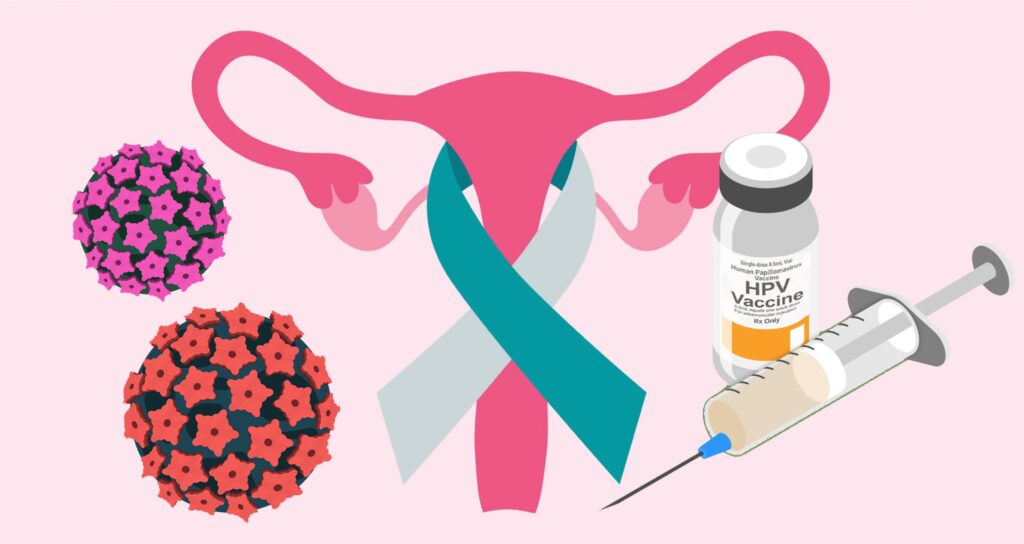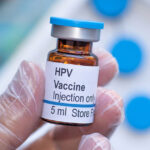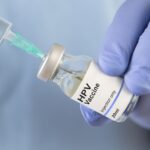Cervical cancer remains one of the leading causes of cancer-related mortality among women globally. The principal causative agent is persistent infection with high-risk human papillomavirus (HPV) types, particularly HPV-16 and HPV-18, which together account for approximately 70% of cervical cancer cases. HPV infects epithelial cells of the cervix, leading to a gradual progression from low-grade lesions to high-grade cervical intraepithelial neoplasia (CIN), and ultimately invasive carcinoma.
The World Health Organization (WHO) and national health authorities recognize HPV vaccination as the most effective primary prevention strategy against cervical cancer.

How HPV Vaccination Works to Prevent Cervical Cancer
HPV vaccines are composed of non-infectious virus-like particles (VLPs) that closely mimic the outer shell of the actual virus. These VLPs stimulate a strong immune response, resulting in the production of neutralizing antibodies that prevent HPV from infecting epithelial cells.
Types of HPV Vaccines:
| Vaccine Name | HPV Types Covered | Primary Use |
|---|---|---|
| Gardasil 9 | 6, 11, 16, 18, 31, 33, 45, 52, 58 | Broadest protection against HPV types |
| Gardasil | 6, 11, 16, 18 | Cervical, anal, vulvar, and vaginal cancers |
| Cervarix | 16, 18 | Specifically targets cervical cancer |
Among these, Gardasil 9 is now globally preferred due to its extensive coverage of high-risk HPV types responsible for most cervical cancer cases.
HPV Vaccine Effectiveness in Preventing Cervical Cancer
Long-term studies and surveillance data confirm that HPV vaccination significantly reduces HPV infections, precancerous lesions, and the incidence of cervical cancer.
- Reduction in HPV infection: Up to 90% decrease in targeted HPV types in vaccinated populations.
- Decrease in CIN 2/3 lesions: More than 85% reduction in high-grade cervical lesions in women under 25 years.
- Early signs of cancer reduction: Countries with high vaccine coverage, like Australia, report declining cervical cancer rates.
Recommended Age and Population Groups for HPV Vaccination
Routine Immunization
- Girls and boys aged 9–14: Ideal age range for vaccination, before exposure to HPV through sexual activity.
- Catch-up vaccination: Recommended up to age 26 for those not previously vaccinated.
Extended Use
- Adults aged 27–45: May benefit based on risk factors and shared clinical decision-making with healthcare providers.
Vaccinating both sexes not only protects individuals but also contributes to herd immunity, reducing the overall transmission of HPV.
Dosing Schedule and Administration Guidelines
Vaccination schedules vary depending on the recipient’s age at the time of first dose:
| Age at First Dose | Number of Doses | Recommended Schedule |
|---|---|---|
| 9–14 years | 2 doses | 0 and 6–12 months |
| 15–45 years | 3 doses | 0, 1–2 months, and 6 months |
Maintaining the correct interval between doses is crucial for ensuring optimal immunity and long-term protection.
Safety and Side Effects of HPV Vaccination
Global regulatory agencies, including the WHO, CDC, and EMA, have thoroughly evaluated the safety of HPV vaccines. They are deemed safe and effective for public use. Common side effects are generally mild:
- Local reactions (pain, redness, swelling at the injection site)
- Low-grade fever
- Fatigue
- Nausea
- Headache
Serious adverse effects are extremely rare. Continuous post-marketing surveillance affirms the vaccines’ excellent safety profile.
Impact of HPV Vaccination on Global Cervical Cancer Burden
Countries with well-implemented HPV vaccination programs show striking public health improvements:
- Australia is on track to become the first country to eliminate cervical cancer as a public health issue by 2035.
- Rwanda achieved over 90% coverage among school-aged girls, setting a global example for vaccine equity.
- United Kingdom observed a substantial decline in cervical cancer incidence among vaccinated age cohorts.
Vaccination also significantly reduces treatment costs for precancerous lesions and invasive cancer, easing the burden on healthcare systems.
Integration with Screening Programs
While HPV vaccination is a powerful preventive tool, it does not eliminate the need for routine cervical cancer screening. Screening remains essential for:
- Detecting existing HPV infections
- Identifying high-grade lesions early
- Managing vaccinated individuals who may still acquire non-vaccine HPV types
Effective cervical cancer prevention strategies should combine HPV vaccination with Pap tests or HPV DNA screening, depending on national guidelines.
Barriers to HPV Vaccination and Solutions
Despite its efficacy, vaccine uptake remains suboptimal in several regions due to:
- Misinformation and safety myths
- Cultural resistance and stigma surrounding sexual health
- Lack of awareness among parents and healthcare providers
- Accessibility issues in low-income countries
Strategic Solutions:
- School-based vaccination programs
- Community education initiatives
- Government-funded vaccine distribution
- Healthcare provider training and engagement
Raising public confidence and dismantling misinformation are critical steps toward expanding vaccine coverage.
HPV vaccination is a scientifically proven and globally endorsed method to prevent cervical cancer. Administering the vaccine to young adolescents—before HPV exposure—provides the strongest protection against the virus and its long-term oncogenic effects. As more countries adopt robust immunization strategies and combine them with effective screening programs, we move closer to achieving the WHO’s goal of eliminating cervical cancer worldwide.

